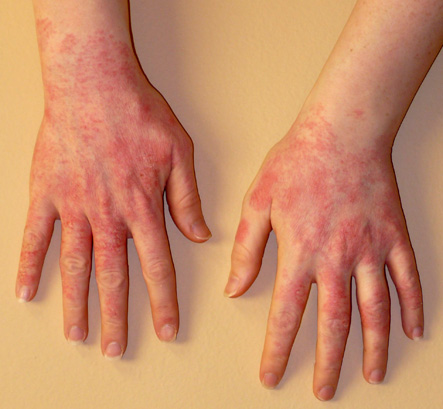 New Health Guide
New Health Guide
When the skin comes in contact with a substance and causes the skin to break out in a red, itchy rash, it is called contact dermatitis. These substances are termed as irritants or allergens. It is very uncomfortable, but not contagious or life-threatening. It is usually seen as dermatitis on hands, but can be seen on any skin part which was exposed. Doctors can diagnose it by taking the exposure history, physical examination and skin patch testing. The treatment regime involves administration of anti-pruritic drugs, topical corticosteroids and avoiding contact with irritants.
 Symptoms develop within few minutes to hours of getting in contact with irritants. It is seen on the part of the body which is exposed to the irritant. The rash or reaction can last for 2 to 4 hours. The most commonly seen signs and symptoms of contact dermatitis are as follows:
Symptoms develop within few minutes to hours of getting in contact with irritants. It is seen on the part of the body which is exposed to the irritant. The rash or reaction can last for 2 to 4 hours. The most commonly seen signs and symptoms of contact dermatitis are as follows:
The severity of the rash depends on the following conditions:
A doctor should be contacted when the following occurs:
Medical care should be sought immediately in case the following occurs:
The 2 main types of contact dermatitis and their causes are discussed below.
This is the most common type of dermatitis and accounts for up to 80% of the cases in the United States. It is non-allergic and inflammatory and occurs when the irritant comes directly in contact with the skin. It can cause irritation after a single exposure or after repeated exposures. It is most frequently seen on the hands and forearms, but can occur on other parts of the body as well.
People who work in areas in which there is constant exposure to irritants or allergens like food preparations, dish washing, hair styling, cosmetology, cleaners, metal workers and construction workers are more prone to contact dermatitis. This type is also known as Occupational Contact Dermatitis.
Some of the most common irritants are:
This type of contact dermatitis occurs when a substance you are allergic to comes in to contact with part of the body and triggers an allergic reaction. It can be localized or it can also be caused by foods that are eaten.
Some of the common allergens are:
Allergic contact dermatitis is seen as frequently in children as in adults.
The first line of treatment involves washing the part of skin with water. It needs to be washed thoroughly to remove all traces of the irritant or allergen causing the dermatitis. Exposure to the irritant or allergen should be avoided and sometimes nothing should be done on the affected area.
One of the most effective measures of preventing and treating contact dermatitis is to use moisturizers or emollients. They keep the skin moist, help in skin repair and prevent further inflammation.
OTC products containing corticosteroid skin creams and ointments helps in reducing inflammation. Doctors also prescribe creams containing drugs called as tacrolimus or pimecrolimus for topical application. Sometimes wet dressings, antipruritic or drying lotions are recommended to reduce other symptoms. Corticosteroid pills can be prescribed in severe cases, starting with high dose, tapered in duration of 12 days.
Want to know more treatments for contact dermatitis? Watch the video below:
By following the steps given below, dermatitis on hands or contact dermatitis of any kind can be prevented: